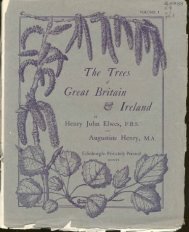THE METAMORPHOSES OF PUBLIUS OVIDIUS NASO
THE METAMORPHOSES OF PUBLIUS OVIDIUS NASO
THE METAMORPHOSES OF PUBLIUS OVIDIUS NASO
You also want an ePaper? Increase the reach of your titles
YUMPU automatically turns print PDFs into web optimized ePapers that Google loves.
FABULA IV.<br />
INO ET MELICERTA IN DEOS MAKINGS.<br />
Obeying the commands of Juno, Tisiphone left the court of Pluto, and came<br />
to the house of Athamas, where she affected him and his wife Ino with<br />
madness. Athamas now eeizes Learchus, his son, and kills him; whereupon<br />
Ino, to avoid his fury, throws herself into the sea together with her son Me-<br />
licerta. By the entreaty of Venus, they are changed into sea-gods. The<br />
companions of Ino, about to cast themselves into the sea through despair, are<br />
changed into rocks and birds.<br />
EXPLICATIO.<br />
TISIPHONE, whose name signifies desire of revenge, clothed with her<br />
bloody robe, girt with a serpent girdle, her head bristling with snakes,<br />
bearing her flaming torch, and a fearful poison, and accompanied by Sor<br />
row, Terror, Fear, and Frenzy, comes forth to execute the vengeance of<br />
the offended Juno. The door-posts tremble beneath her tread, the doors<br />
grow pale, and the very sun shrinks back from her presence. No won<br />
der that Athamas is affrighted, and feels the awful power of the dread<br />
deity before him.<br />
Having abundantly proved before, that Bacchus was the Noah of Scrip<br />
ture, it is easy to recognise in the nurse of Bacchus, Ino, by metathesis,<br />
Ion, the lona, or Dove, which is connected with the story of Noah, and<br />
which, on ancient coins especially those of Apamea is sometimes found<br />
brooding over an ark; and is an allegorical representation of the Spirit<br />
of God watching over the human family when enclosed in that receptacle<br />
which divine wisdom had provided. As Venus and the Dove are<br />
always found associated, and as Venus is fabled to arise from the sea, de<br />
noting, probably, the new creation as coming forth from the sea, after the<br />
Deluge, we may regard Ino as the same as Venus; for, in her name Leu-<br />
cothoe, or Leucothea, as it is more commonly written, we have the white-<br />
goddess, corresponding exactly to Venus Aphrodite, the goddess of the<br />
foam.<br />
Palaemon on ancient coins and medals is often found upon the back of<br />
a Cetus, which is a huge fish that is evidently a type of the Ark. Some<br />
times the Ark itself is represented, and above it a Cetus with Palffimon<br />
on its back. It is most proper to regard Palremon as a type of the Ark of<br />
Noah. Mythologically the Ark may be said to be the son of the Dove.<br />
Its etymology will show it a type of the Ark, for Palaemon is Pake Man,<br />
or Maon, the ancient moon. Now the moon has always been a type of<br />
the Baris of Osiris, which is represented in the shape of a lunette.<br />
Hence, Osiris is said to have " entered the moon;" and, hence, in allusion<br />
to the Ark as the mother of the renovated world, the moon was worshipped<br />
anciently as " the mother of the whole world." It has been shown be<br />
fore that Osiris and Noah were the same, and that the Baris of the former<br />
was the Ark of the latter<br />
280<br />
EC mora; Tisiphone madefactam sanguine sumit<br />
Importuna facem: fluidoque cruore rubentem<br />
Induitur pallarn; tortoque incingitur angue:<br />
Egrediturque domo. Luctus comitantur euntcm,<br />
Et Pavor, et Terror, trepidoque Insama vultu. 5<br />
Limine constiterat; pcstes tremuisse feruntur<br />
^Eolii; pallorque fores infecit acemas ;<br />
Solque locum fugit. Mcnstris exterrita conjux,<br />
Territus est Athamas; tectoque exire parabant.<br />
Obstitit infelix, aditumque obsedit Erinnys: 10<br />
NOT.E.<br />
H. Cruc'e ruJientem: red wiih blood. Virgil describes Tisiphone<br />
as clad in the same habiliments:<br />
Sublime on these a tower of ptcel IB reared,<br />
And dire Ti ipb"»"* there keeps tile ward,<br />
Girt in her sanguine gown, by night and day. JENE1D Ti. 664.<br />
And o'er her shoulders was a gnrmcnt thrown<br />
Babbled in human blood; and in her look<br />
Was horror! and a deep funereal cry<br />
3. Torto angue. A snake bound around<br />
her waist formed a girdle.<br />
Two grisly snakes<br />
ITung from their girdles, and with forked tongues<br />
Licked their Infected jawB. and violent gnashed<br />
Their fangs fell glaring.<br />
Broke from her lipe. HESIOD'B SDIELD <strong>OF</strong> HERCULES.<br />
IlEtion'e SHIELD <strong>OF</strong> HERCULES.<br />
troop forms ihc irain of the Fury. Seneca<br />
describes Wars as accompanied by a train<br />
ol similar terror:<br />
Letnm. Luesqnc, Mors, Labor, Taben, Dolor,<br />
Comitgtus illo, dignus. (Enmjs, Aet. iii.<br />
8. Conjux. Ino, I he wife of Athamas.<br />
10. Infelix: unhappy ; that causes un<br />
Ltictus comitantur. What a fearful I happiness ; pernicious.<br />
36 2A2 281













